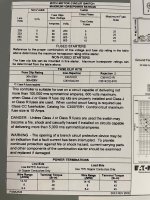ChefTurnedSparky
Member
- Location
- Columbus, Ohio
- Occupation
- Electrician
In a motor starter, what’s the purpose? Are they that much faster to break the circuit than a CB? Is it just standard practice to put them there?
What type and size would I need for a 20A circuit, 1 hp motor? 208, single phase.
Crew lead told me to take picture of the data sheets in the starter, the clips and send it to purchasing with the HP/ fla of the motor. But that’s no fun for anyone. I want to know HOW and WHY!
What type and size would I need for a 20A circuit, 1 hp motor? 208, single phase.
Crew lead told me to take picture of the data sheets in the starter, the clips and send it to purchasing with the HP/ fla of the motor. But that’s no fun for anyone. I want to know HOW and WHY!


